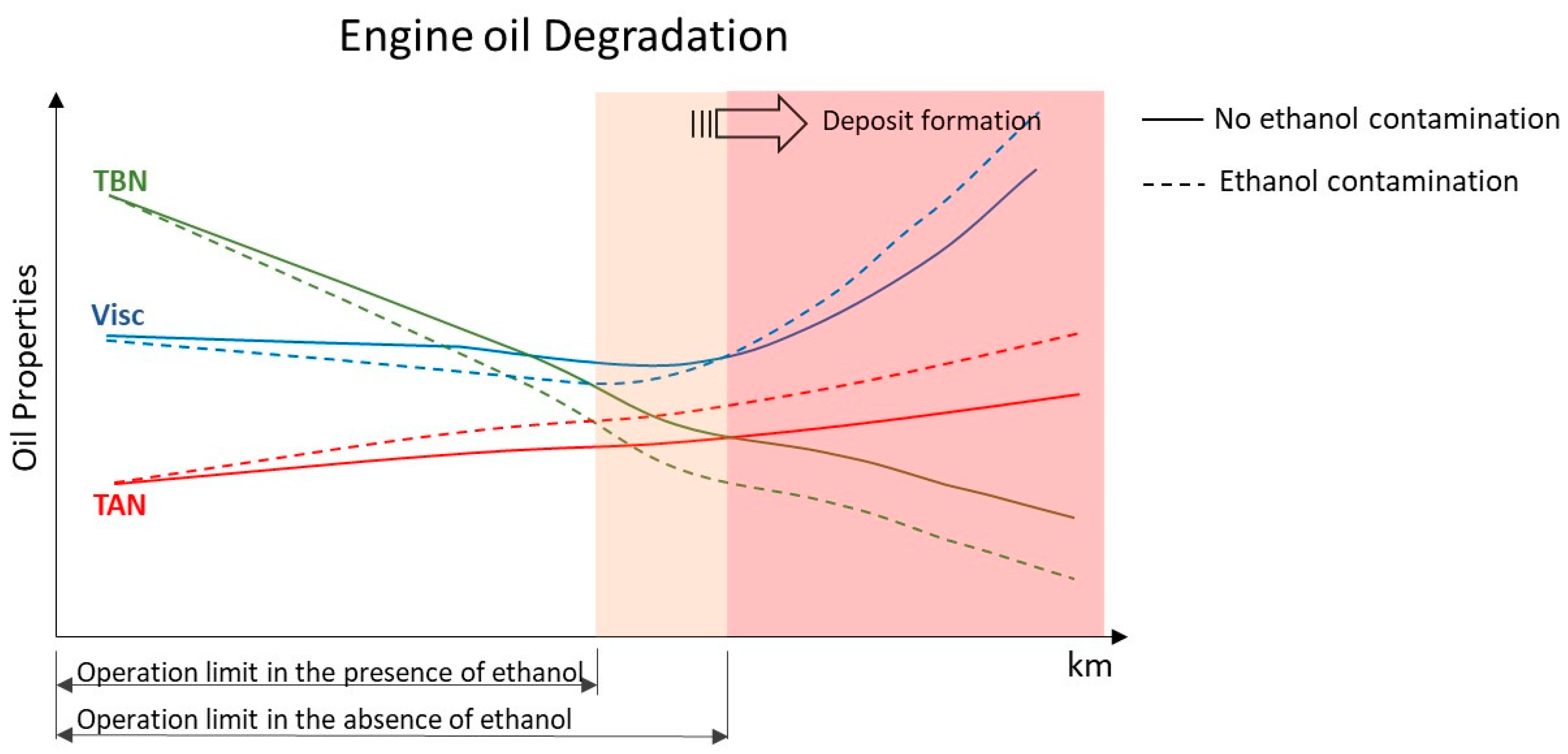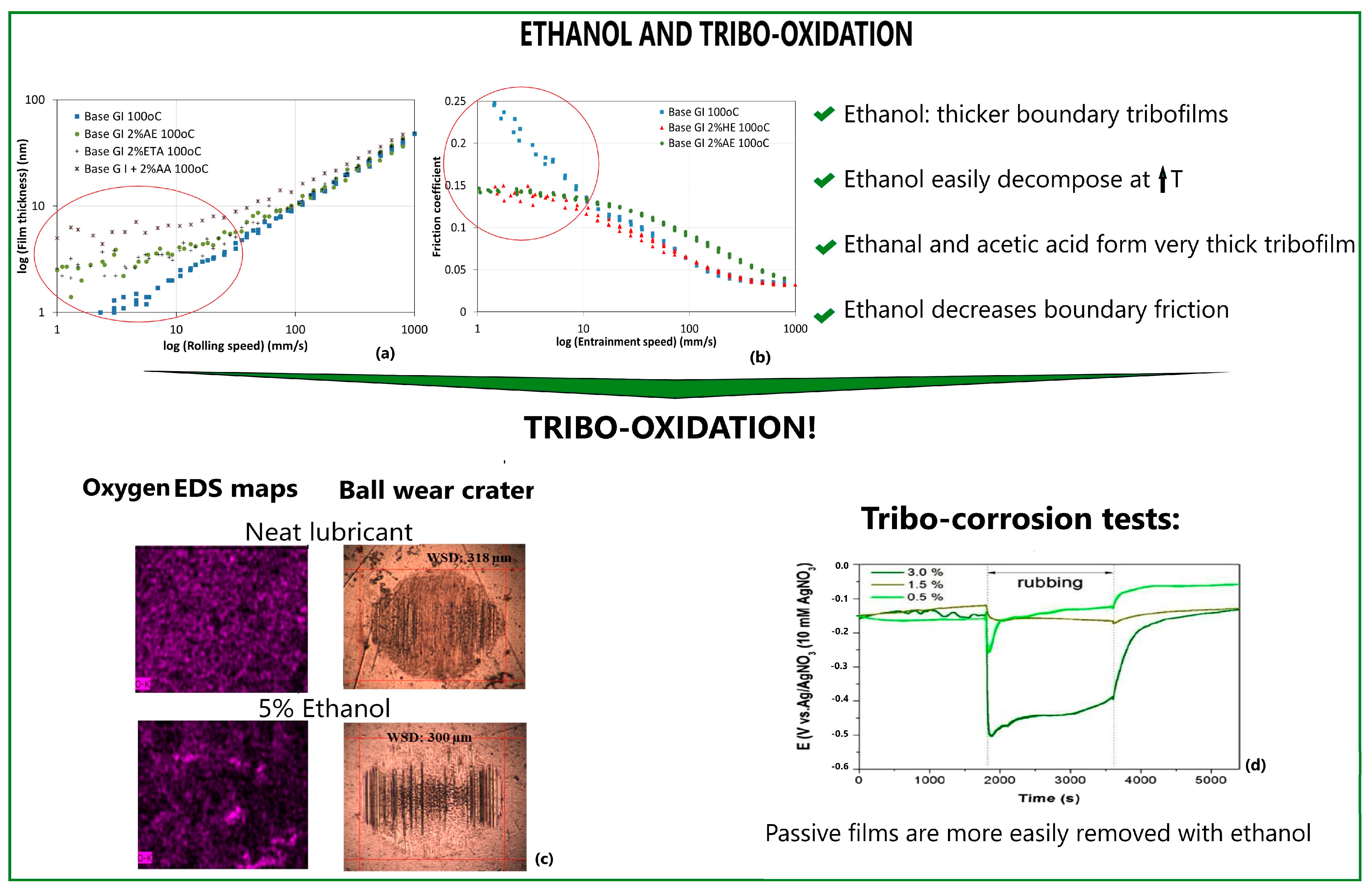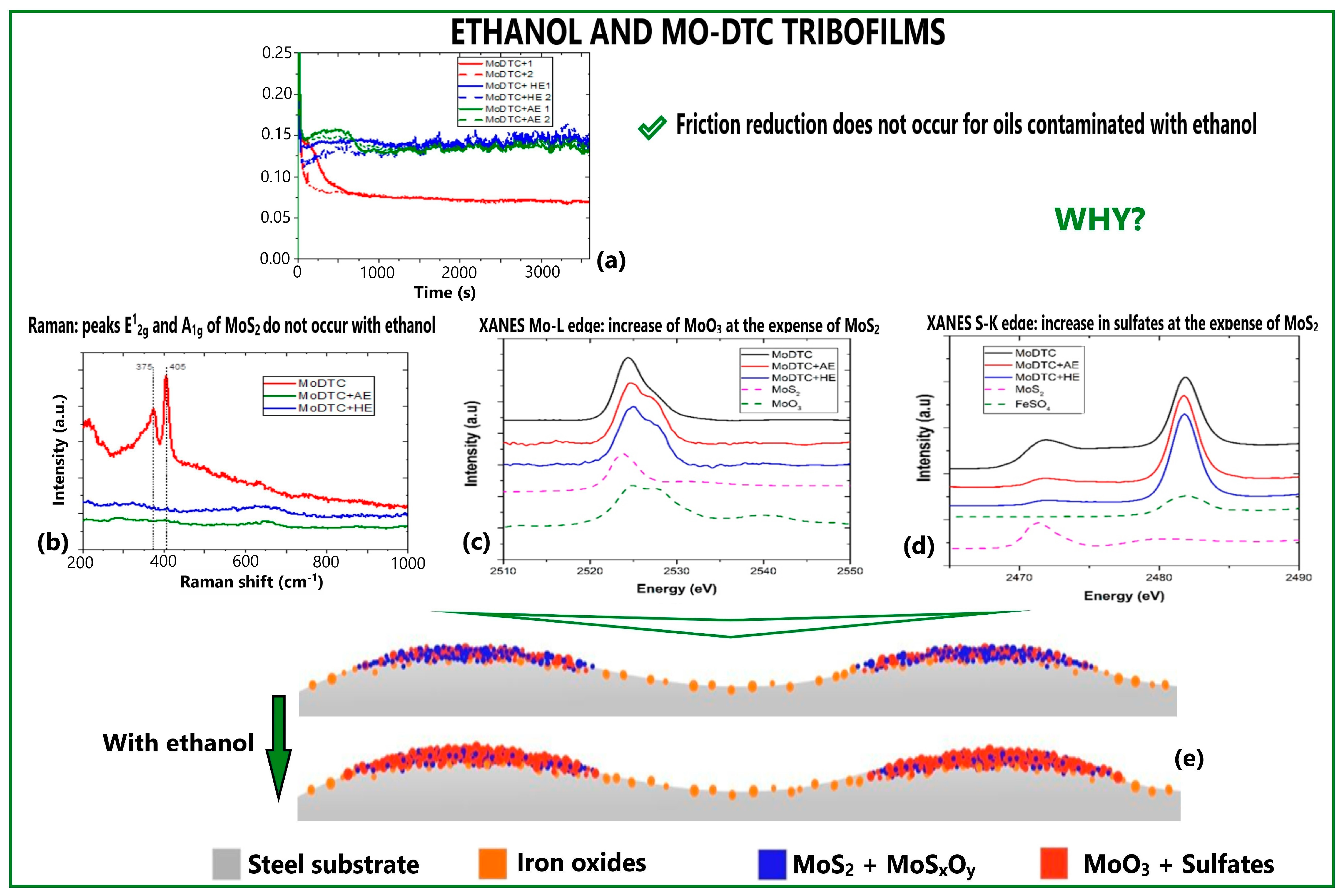Current Knowledge on Friction, Lubrication, and Wear of Ethanol-Fuelled Engines—A Review
Abstract
1. Introduction
2. Effects of Ethanol on Lubricant Properties
2.1. Effect of Ethanol Fuel on Lubricant’s Physicochemical Properties
2.2. Deposit Formation Due to Ethanol Contamination
3. General Trend of the Impact of Ethanol on Friction and Wear
4. Effects of Ethanol on the Formation and Durability of Tribofilms
4.1. Ethanol and ZDDP Tribofilms
4.2. Ethanol and Tribo-Oxidation
4.3. Interaction of Ethanol and Friction Modifiers
5. Knowledge Gaps, Future Trends, and Lubricant Guidelines
Author Contributions
Funding
Data Availability Statement
Acknowledgments
Conflicts of Interest
References
- O’Neill, S. COP26: Some Progress, but Nations still Fiddling While World Warms; Elsevier: Amsterdam, The Netherlands, 2022. [Google Scholar]
- Bouckaert, S.; Pales, A.F.; McGlade, C.; Remme, U.; Wanner, B.; Varro, L.; D’Ambrosio, D.; Spencer, T. Net Zero by 2050: A Roadmap for the Global Energy Sector; International Energy Agency: Paris, France, 2021; pp. 1–224.
- Abdelilah, Y.; Bahar, H.; Criswell, T.; Bojek, P.; Briens, F.; Moorhouse, J.; Martinez, L.M. Renewables 2022 Analysis and Forecast to 2027; International Energy Agency: Paris, France, 2022; pp. 1–159.
- Sudan Reddy Dandu, M.; Nanthagopal, K. Tribological aspects of biofuels–A review. Fuel 2019, 258, 116066. [Google Scholar] [CrossRef]
- Dutcher, D.D.; Stolzenburg, M.R.; Thompson, S.L.; Medrano, J.M.; Gross, D.S.; Kittelson, D.B.; McMurry, P.H. Emissions from Ethanol-Gasoline Blends: A Single Particle Perspective. Atmosphere 2011, 2, 182–200. [Google Scholar] [CrossRef]
- Agarwal, A.K.; Singh, A.P.; Gupta, T.; Agarwal, R.A.; Sharma, N.; Pandey, S.K.; Ateeq, B. Toxicity of exhaust particulates and gaseous emissions from gasohol (ethanol blended gasoline)-fuelled spark ignition engines. Environ. Sci. Process. Impacts 2020, 22, 1540–1553. [Google Scholar] [CrossRef]
- Maricq, M.M. Soot formation in ethanol/gasoline fuel blend diffusion flames. Combust. Flame 2012, 159, 170–180. [Google Scholar] [CrossRef]
- Banerji, A.; Edrisy, A.; Francis, V.; Alpas, A.T. Effect of bio-fuel (E85) addition on lubricated sliding wear mechanisms of a eutectic Al–Si alloy. Wear 2014, 311, 1–13. [Google Scholar] [CrossRef]
- Khuong, L.S.; Masjuki, H.H.; Zulkifli, N.W.M.; Mohamad, E.N.; Kalam, M.A.; Alabdulkarem, A.; Arslan, A.; Mosarof, M.H.; Syahir, A.Z.; Jamshaid, M. Effect of gasoline–bioethanol blends on the properties and lubrication characteristics of commercial engine oil. RSC Adv. 2017, 7, 15005–15019. [Google Scholar] [CrossRef]
- Khuong, L.S.; Zulkifli, N.W.M.; Masjuki, H.H.; Mohamad, E.N.; Arslan, A.; Mosarof, M.H.; Azham, A. A review on the effect of bioethanol dilution on the properties and performance of automotive lubricants in gasoline engines. RSC Adv. 2016, 6, 66847–66869. [Google Scholar] [CrossRef]
- Wicker, R.; Hutchison, P.; Acosta, O.; Matthews, R. Practical Considerations for an E85-Fueled Vehicle Conversion; SAE Technical Paper: Warrendale, PA, USA, 1999. [Google Scholar]
- Shanta, S.M.; Molina, G.J.; Soloiu, V. Tribological Effects of Mineral-Oil Lubricant Contamination with Biofuels: A Pin-on-Disk Tribometry and Wear Study. Adv. Tribol. 2011, 2011, 820795. [Google Scholar] [CrossRef]
- Boons, M.; Bulk, R.V.D.; King, T. The impact of E85 use on lubricant performance. SAE Pap. 2008, 1, 1763. [Google Scholar]
- Schwartz, S.E. Observations through a Transparent Oil Pan During Cold-Start, Short-Trip Service; SAE Technical Paper: Warrendale, PA, USA, 1991. [Google Scholar] [CrossRef]
- Chui, G.K.; Baker, R.E.; Pinto, F.B.P. Lubrication behaviour in ethanol-fueled engines. In Proceedings of the 4th Symposium on Alcohol fuels, Gurujá, Brazil, 5–8 October 1980. [Google Scholar]
- Chui, G.K.; Millard, D.H.T. Development and Testing of Crankcase Lubricants for Alcohol Fueled Engines; SAE paper 811203; SAE Technical Paper: Warrendale, PA, USA, 1981. [Google Scholar]
- Khalifa, G.A. Effect of Hydrous Ethanol on Crankcase Oil Dilution (Carburetion, Fumigation); Oregon State University: Corvallis, OR, USA, 1985. [Google Scholar]
- Crepaldi, J.; Fujita, H.; Tomanik, E.; Galvão, C.; Balarini, R.; do Vale, J.L. A New Tribology Test Procedure to Investigate Ethanol Dilution on Engine Oils; 0148-7191; SAE Technical Paper: Warrendale, PA, USA, 2018. [Google Scholar]
- Taylor, R.I. Fuel-Lubricant Interactions: Critical Review of Recent Work. Lubricants 2021, 9, 92. [Google Scholar] [CrossRef]
- Calabokis, O.P.; Nuñez de la Rosa, Y.; Borges, P.C.; Cousseau, T. Effect of an Aftermarket Additive in Powertrain Wear and Fuel Consumption of Small-Capacity Motorcycles: A Lab and Field Study. Lubricants 2022, 10, 143. [Google Scholar] [CrossRef]
- Mitan, N.M.M.; Ramlan, M.S.; Nawawi, M.Z.H.; Zackris Kindamas, Z. Preliminary study on effect of oil additives in engine lubricant on four-stroke motorcycle engine. Mater. Today Proc. 2018, 5, 21737–21743. [Google Scholar] [CrossRef]
- Wolak, A. Changes in Lubricant Properties of Used Synthetic Oils Based on the Total Acid Number. Meas. Control 2018, 51, 65–72. [Google Scholar] [CrossRef]
- Agocs, A.; Nagy, A.L.; Tabakov, Z.; Perger, J.; Rohde-Brandenburger, J.; Schandl, M.; Besser, C.; Dörr, N. Comprehensive assessment of oil degradation patterns in petrol and diesel engines observed in a field test with passenger cars—Conventional oil analysis and fuel dilution. Tribol. Int. 2021, 161, 107079. [Google Scholar] [CrossRef]
- Tippayawong, N.; Sooksarn, P. Assessment of lubricating oil degradation in small motorcycle engine fueled with gasohol. Maejo Int. J. Sci. Technol. 2010, 4, 201–209. [Google Scholar]
- Ajayi, O.O.; Lorenzo-Martin, C.; Fenske, G.; Corlett, J.; Murphy, C.; Przesmitzki, S. Bioderived Fuel Blend Dilution of Marine Engine Oil and Impact on Friction and Wear Behavior. J. Tribol. 2015, 138, 021603. [Google Scholar] [CrossRef]
- Wu, Y.; Li, W.; Zhang, M.; Wang, X. Oxidative degradation of synthetic ester and its influence on tribological behavior. Tribol. Int. 2013, 64, 16–23. [Google Scholar] [CrossRef]
- De Feo, M.; Minfray, C.; De Barros Bouchet, M.I.; Thiebaut, B.; Le Mogne, T.; Vacher, B.; Martin, J.M. Ageing impact on tribological properties of MoDTC-containing base oil. Tribol. Int. 2015, 92, 126–135. [Google Scholar] [CrossRef]
- Costa, H.L.; Evangelista, K.S.; Cousseau, T.; Acero, J.S.R.; Kessler, F. Use of XANES and XPS to investigate the effects of ethanol contamination on anti-wear ZDDP tribofilms. Tribol. Int. 2021, 159, 106997. [Google Scholar] [CrossRef]
- Cousseau, T.; Ruiz Acero, J.S.; Sinatora, A. Tribological response of fresh and used engine oils: The effect of surface texturing, roughness and fuel type. Tribol. Int. 2016, 100, 60–69. [Google Scholar] [CrossRef]
- Ruiz-Acero, J.S.; Kessler, F.; Costa, H.L.; Cousseau, T. The effect of ethanol fuel dilution on oil performance and MoDTC tribofilm formation and composition. Friction, 2023; under review. [Google Scholar]
- De Feo, M.; Minfray, C.; De Barros Bouchet, M.I.; Thiebaut, B.; Martin, J.M. MoDTC friction modifier additive degradation: Correlation between tribological performance and chemical changes. RSC Adv. 2015, 5, 93786–93796. [Google Scholar] [CrossRef]
- Costa, H.L.; Spikes, H. Effects of Ethanol Contamination on Friction and Elastohydrodynamic Film Thickness of Engine Oils. Tribol. Trans. 2015, 58, 158–168. [Google Scholar] [CrossRef]
- Costa, H.L.; Spikes, H. Interactions of Ethanol with Friction Modifiers in Model Engine Lubricants. Lubricants 2019, 7, 101. [Google Scholar] [CrossRef]
- Costa, H.L.; Spikes, H.A. Impact of ethanol on the formation of antiwear tribofilms from engine lubricants. Tribol. Int. 2016, 93 Pt A, 364–376. [Google Scholar] [CrossRef]
- De Silva, P.R.; Priest, M.; Lee, P.M.; Coy, R.C.; Taylor, R.I. Tribometer investigation of the frictional response of piston rings with lubricant contaminated with the gasoline engine biofuel ethanol and water. Proc. Inst. Mech. Eng. Part J. J. Eng. Tribol. 2011, 225, 347–358. [Google Scholar] [CrossRef]
- Kumar, V.; Agarwal, A.K. Friction, Wear, and Lubrication Studies of Alcohol-Fuelled Engines. In Advances in Engine Tribology; Kumar, V., Agarwal, A.K., Jena, A., Upadhyay, R.K., Eds.; Springer Singapore: Singapore, 2022; pp. 9–29. [Google Scholar] [CrossRef]
- Besser, C.; Schneidhofer, C.; Dörr, N.; Novotny-Farkas, F.; Allmaier, G. Investigation of long-term engine oil performance using lab-based artificial ageing illustrated by the impact of ethanol as fuel component. Tribol. Int. 2012, 46, 174–182. [Google Scholar] [CrossRef]
- Gaffney, J.S.; Marley, N.A. The impacts of combustion emissions on air quality and climate—From coal to biofuels and beyond. Atmos. Environ. 2009, 43, 23–36. [Google Scholar] [CrossRef]
- dos Santos Filho, D.; Tschiptschin, A.P.; Goldenstein, H. Effects of ethanol content on cast iron cylinder wear in a flex-fuel internal combustion engine–A case study. Wear 2018, 406–407, 105–117. [Google Scholar] [CrossRef]
- Crepaldi, J.; Tomanik, E.; Souza, R.; Balarini, R.; Profito, F.; Fujita, H.; do Vale, J. Impact of ethanol on lubricant additive performance at Piston Ring-Cylinder Liner Interface. In Proceedings of the Web Forum SAE Brazil, São Paulo, Brazil, 17–20 May 2021; p. 2021–2036–0002. [Google Scholar]
- Banerji, A.; Lukitsch, M.J.; Alpas, A.T. Friction reduction mechanisms in cast iron sliding against DLC: Effect of biofuel (E85) diluted engine oil. Wear 2016, 368–369, 196–209. [Google Scholar] [CrossRef]
- Bandeira, A.L.; Trentin, R.; Aguzzoli, C.; Maia da Costa, M.E.H.; Michels, A.F.; Baumvol, I.J.R.; Farias, M.C.M.; Figueroa, C.A. Sliding wear and friction behavior of CrN-coating in ethanol and oil–ethanol mixture. Wear 2013, 301, 786–794. [Google Scholar] [CrossRef]
- Lenauer, C.; Tomastik, C.; Wopelka, T.; Jech, M. Piston ring wear and cylinder liner tribofilm in tribotests with lubricants artificially altered with ethanol combustion products. Tribol. Int. 2015, 82, 415–422. [Google Scholar] [CrossRef]
- Oguma, M.; Matsuno, M.; Kaitsuka, M.; Higurashi, K. Evaluation of hydrous ethanol fuel lubricity by HFRR. SAE Tech. Pap. 2016. [Google Scholar] [CrossRef]
- Dubois, T.; Abiad, L.; Caine, P. Investigating the Impact of Ethanol on the Lubricity of Gasoline and on the Lubricity Improvers Efficiency. SAE Tech. Pap. 2017. [Google Scholar] [CrossRef]
- Shirani, A.; Li, Y.; Smith, J.; Curry, J.F.; Lu, P.; Wilson, M.; Chandross, M.; Argibay, N.; Berman, D. Mechanochemically driven formation of protective carbon films from ethanol environment. Mater. Today Chem. 2022, 26, 101112. [Google Scholar] [CrossRef]
- Ferrarese, A.; Marques, G.; Tomanik, E.; Bruno, R.; Vatavuk, J. Piston ring tribological challenges on the next generation of flex-fuel engines. SAE Int. J. Engines 2010, 3, 85–91. [Google Scholar] [CrossRef]
- Radi, P.A.; Vieira, A.; Manfroi, L.; Nass, K.C.d.F.; Ramos, M.A.R.; Leite, P.; Martins, G.V.; Jofre, J.B.F.; Vieira, L. Tribocorrosion and corrosion behavior of stainless steel coated with DLC films in ethanol with different concentrations of water. Ceram. Int. 2019, 45, 9686–9693. [Google Scholar] [CrossRef]
- Dias, L.C.; Pintaude, G.; Vittorino, A.A.O.F.; Costa, H.L. ZDDP Tribofilm Formation from a Formulated Oil on Textured Cylinder Liners. Lubricants 2022, 10, 118. [Google Scholar] [CrossRef]
- Zhang, J.; Spikes, H. On the mechanism of ZDDP antiwear film formation. Tribol. Lett. 2016, 63, 24. [Google Scholar] [CrossRef]
- Pereira, G.; Lachenwitzer, A.; Munoz-Paniagua, D.; Kasrai, M.; Norton, P.R.; Abrecht, M.; Gilbert, P. The role of the cation in antiwear films formed from ZDDP on 52100 steel. Tribol. Lett. 2006, 23, 109–119. [Google Scholar] [CrossRef]
- Martin, J.M. Antiwear mechanisms of zinc dithiophosphate: A chemical hardness approach. Tribol. Lett. 1999, 6, 1–8. [Google Scholar] [CrossRef]
- Parsaeian, P.; Van Eijk, M.C.; Nedelcu, I.; Neville, A.; Morina, A. Study of the interfacial mechanism of ZDDP tribofilm in humid environment and its effect on tribochemical wear; Part I: Experimental. Tribol. Int. 2017, 107, 135–143. [Google Scholar] [CrossRef]
- Olsson, B.; Mattsson, L.; Nilsson, P.; Otterholm, B.; Wirmark, G. Paper XVI (ii) A Model Study of Lubricant Additive Reactions in the Presence of Methanol. In Tribology Series; Elsevier: Amsterdam, The Netherlands, 1991; Volume 18, pp. 429–437. [Google Scholar]
- Cen, H.; Morina, A.; Neville, A.; Pasaribu, R.; Nedelcu, I. Effect of water on ZDDP anti-wear performance and related tribochemistry in lubricated steel/steel pure sliding contacts. Tribol. Int. 2012, 56, 47–57. [Google Scholar] [CrossRef]
- Nedelcu, I.; Piras, E.; Rossi, A.; Pasaribu, H. XPS analysis on the influence of water on the evolution of zinc dialkyldithiophosphate–derived reaction layer in lubricated rolling contacts. Surf. Interface Anal. 2012, 44, 1219–1224. [Google Scholar] [CrossRef]
- Hu, X.; Wo, H.; Han, G.; Lu, Y. Tribochemical effect of impurities in zinc dialkyldithiophosphate in engine oil. Lubr. Sci. 2003, 15, 351–360. [Google Scholar] [CrossRef]
- dos Santos, R.M.; Alves, S.M. Effect of fuel contamination on tribological properties of flex-fuel engines lubricating oils. Surf. Topogr. Metrol. Prop. 2022, 10, 044004. [Google Scholar] [CrossRef]
- Spikes, H. Friction Modifier Additives. Tribol. Lett. 2015, 60, 5. [Google Scholar] [CrossRef]
- Xu, D.; Wang, C.; Espejo, C.; Wang, J.; Neville, A.; Morina, A. Understanding the Friction Reduction Mechanism Based on Molybdenum Disulfide Tribofilm Formation and Removal. Langmuir 2018, 34, 13523–13533. [Google Scholar] [CrossRef]
- Morina, A.; Neville, A.; Priest, M.; Green, J.H. ZDDP and MoDTC interactions and their effect on tribological performance—Tribofilm characteristics and its evolution. Tribol. Lett. 2006, 24, 243–256. [Google Scholar] [CrossRef]
- Martin, J.; Le Mogne, T.; Grossiord, C.; Palermo, T. Tribochemistry of ZDDP and MoDDP chemisorbed films. Tribol. Lett. 1996, 2, 313–326. [Google Scholar] [CrossRef]
- Vyavhare, K.; Sharma, V.; Sharma, V.; Erdemir, A.; Aswath, P.B. XANES Study of Tribofilm Formation with Low Phosphorus Additive Mixtures of Phosphonium Ionic Liquid and Borate Ester. Front. Mech. Eng. 2021, 7, 671457. [Google Scholar] [CrossRef]






Disclaimer/Publisher’s Note: The statements, opinions and data contained in all publications are solely those of the individual author(s) and contributor(s) and not of MDPI and/or the editor(s). MDPI and/or the editor(s) disclaim responsibility for any injury to people or property resulting from any ideas, methods, instructions or products referred to in the content. |
© 2023 by the authors. Licensee MDPI, Basel, Switzerland. This article is an open access article distributed under the terms and conditions of the Creative Commons Attribution (CC BY) license (https://creativecommons.org/licenses/by/4.0/).
Share and Cite
Costa, H.L.; Cousseau, T.; Souza, R.M. Current Knowledge on Friction, Lubrication, and Wear of Ethanol-Fuelled Engines—A Review. Lubricants 2023, 11, 292. https://doi.org/10.3390/lubricants11070292
Costa HL, Cousseau T, Souza RM. Current Knowledge on Friction, Lubrication, and Wear of Ethanol-Fuelled Engines—A Review. Lubricants. 2023; 11(7):292. https://doi.org/10.3390/lubricants11070292
Chicago/Turabian StyleCosta, Henara Lillian, Tiago Cousseau, and Roberto Martins Souza. 2023. "Current Knowledge on Friction, Lubrication, and Wear of Ethanol-Fuelled Engines—A Review" Lubricants 11, no. 7: 292. https://doi.org/10.3390/lubricants11070292
APA StyleCosta, H. L., Cousseau, T., & Souza, R. M. (2023). Current Knowledge on Friction, Lubrication, and Wear of Ethanol-Fuelled Engines—A Review. Lubricants, 11(7), 292. https://doi.org/10.3390/lubricants11070292





